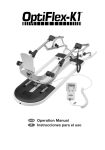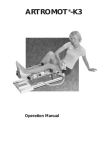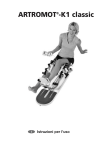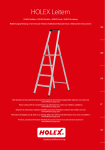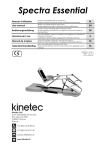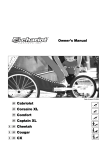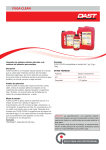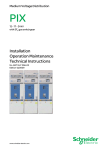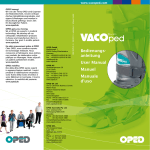Download ARTROMOT®-SP3 - Patterson Medical
Transcript
ARTROMOT®-SP3 D USA/GB F E I NL Gebrauchsanweisung Operation Manual Mode d’emploi Instrucciones para el uso Istruzioni per l’uso Gebruiksaanwijzing Gerätebeschreibung Device description Description de l’appareil Desripción del aparato Descrizione dell’apparecchiatura Gebruikershandleiding 1 2 1 3 4 5 6 7 8 9 24 23 10 22 11 12 13 19 21 20 18 17 16 3 15 14 Contents Description of the ARTROMOT®-SP3 System 3 ARTROMOT®-SP3 setup illustrations 224 Symbol overview 221 1. 2. How to use the CPM device 41 1.1 1.2 1.3 1.4 41 41 41 41 Fields of application Therapy objectives Indications Contraindications Description of the ARTROMOT®-SP3 42 2.1 2.2 2.3 2.4 42 43 46 47 Description of the device components Description of the programming unit Explanation of symbols Explanation of symbols (connections and nameplate) 3. Safety information 4. Device setup 51 4.1 4.2 51 52 5. Connecting the device, performance check Adjusting the device to the patient Setting the treatment values 5.1 5.2 5.3 5.4 5.5 6. 48 54 General information on programming ARTROMOT®-SP3 Programming ARTROMOT®-SP3 Standard Treatment value details – Standard models Programming ARTROMOT®-SP3 Comfort Protocol details – Comfort models 54 55 56 60 60 Care, Maintenance, Transport, Conversion 65 6.1 6.2 6.3 6.4 65 65 66 67 Care Maintenance (fuse replacement) Transport Conversion 7. Environmental Protection Statement 68 8. Specifications 68 9. IEC 60601-1-2:2001 69 9.1 9.2 9.3 69 70 72 Electromagnetic emissions Electromagnetic immunity Recommended Separation Distances 10. Contact 72 11. Technical service 73 11.1 Technical Hotline 11.2 Shipment 11.3 Spare Parts 73 73 73 12. Declaration of conformity 74 40 1. How to use the CPM device 1.3 Indications ARTROMOT®-SP3 is a motor-operated Continuous Passive Motion (CPM) device providing motion to the ankle joint. The CPM device is indicated in the treatment of most injuries and diseases of the ankle joint as well as in the postoperative treatment after joint surgery and in the treatment of joint diseases. Examples: Suitable for use in hospitals, clinics, general practices and rental services, it is an important supplement to medical and therapeutic treatment. - joint distortion and contusion - arthrotomy and arthroscopy procedures in combination with synovectomy, arthrolysis or other intra-articular interventions 1.2 Therapy objectives - mobilization of joints in anesthetized patients CPM therapy with ARTROMOT®-SP3 is mainly used to prevent the negative effects of immobilization, to allow patients to regain painless mobility of joints at an early stage and to promote healing and achieve a positive functional result. - exercise-stable fractures after surgery, pseudoarthrosis and osteotomy - myoplasty - arthroplasties including implantation of endoprostheses Other objectives of therapy include: - improvement of joint metabolism - prevention of joint stiffness 1.4 Contraindications - promotion of the regeneration and healing of cartilage and damaged ligaments Do NOT use ARTROMOT®-SP3 on patients with: - improved lymph and blood circulation - acute inflammatory processes in the joints, unless on the order of a physician - thrombosis and embolism prophylaxis - spastic paralysis - faster hematoma/fluid resorption - unstable osteosynthesis 41 English 1.1 Fields of application 2. Description of the ARTROMOT®-SP3 The motorized CPM device provides the following passive motion to the ankle joint: 2.1 Description of the device components plantar flexion / dorsal extension 50° / 0° / 40° Note: Please fold out page 3! inversion / eversion 40° / 0° / 20° 1. Clamping levers to adjust the height of the calf support assembly It can be reconfigured for use on either side and allows patients to exercise in bed and while sitting on a chair. 2. Calf support assembly 3. Motor A (center of rotation for dorsal extension/plantar flexion) 4. Bracket for programming unit Note! 5. Clamping lever to adjust the inclination of the carriage To unambiguously represent the current position of the CPM device, the values for plantar flexion and inversion are marked with the symbol "-" both on the display and in this document. 6. Aiming pin for adjustment of the rotational axis of the upper ankle joint 7. Footplate 8. Knurled screw for adjustment of the footplate height 9. Knurled screw to adjust the footplate to the leg length These are some of the ARTROMOT®-SP3 features: 10. Motor B - anatomically correct setup 11. Footplate bracket - physiological movements 12. Thumbscrew to secure motor B on the moving bracket for dorsal extension / plantar flexion - programming unit for precise adjustment of patient-specific therapy values 13. Bore hole to mount motor B to the moving bracket for dorsal extension/ plantar flexion - symbols for easy operation of the programming unit - chip card for storage of the programmed therapy parameters 14. CPM base Biocompatibility 16. Power switch (ON/OFF) Those parts of the ARTROMOT®-SP3 device that come into contact with the patient when the device is used as intended, are designed to fulfil the biocompatibility requirements of the applicable standards. 17. Fuse cap 15. Moving bracket for dorsal extension/ plantar flexion 18. Connection for power cord 19. Locking device to adjust the height of the carriage 20. Perforation to set the height of the carriage 21. Patient chip card1 22. Programming unit 23. Nameplate 24. Connection for programming unit 42 2.2 Description of the programming unit 2.2.1 Programming unit in normal mode set angle of motor A set angle of motor B current position of motor A (arrow pointing up = dorsal extension arrow pointing down = plantar flexion) current position of motor B (left or right - solid foot symbol / arrow pointing inward = inversion arrow pointing outward = eversion) selected therapy protocol therapy timer set eversion value set dorsal extension value set inversion value set plantar flexion value motor B - selected direction of motion motor A - selected direction of motion parameter keys MENU key “+” key START key STOPkey “-” key Devices of the ARTROMOT®-SP3 product family with patient chip card only 1 43 English Patient chip card1 2.2.2 Programming unit in MENU selection mode set carriage angle for dorsal extension / plantar flexion set carriage angle for inversion / eversion current position of motor B (left or right - solid foot symbol / arrow pointing inward = inversion arrow pointing outward = eversion) current position of motor A (arrow pointing up = dorsal extension arrow pointing down = plantar flexion) parameters available for selection and corresponding parameter keys selected MENU level 2.2.3 Programming unit set to ROM programming current maximum dorsal extension value selected function set carriage angle selected parameter (here: dorsal extension) current maximum plantar flexion value 44 selected function status of the selected function (here: speed) 45 English 2.2.4 Programming unit in general programming mode 2.3 Explanation of symbols Also refer to symbol overview on page 221 Standard protocols: Comfort protocols: dorsal extension warm up protocol plantar flexion isolation protocol inversion dorsal extension / plantar flexion therapy documentation eversion inversion / eversion therapy documentation pause timer stretching in dorsal extension speed stretching in plantar flexion new patient stretching in inversion load reversal motor A load reversal motor B stretching in eversion motor A ON/OFF motor B ON/OFF transport setting synchronized/nonsynchronized mode total therapy time service menu 46 2.4 Explanation of symbols (connections and nameplate) English alternating current protective earth connection type B applied part power switch OFF power switch ON Refer to accompanying documents Do not dispose of product with unsorted household or municipal waste. 47 3. Safety information Definitions Safety information It is mandatory to read the safety statements before use of the CPM device. The safety statements are classified as follows: Danger Explosion hazard – ARTROMOT®-SP3 is not designed for use in areas where an explosion hazard may occur. An explosion hazard may result from the use of flammable anesthetics, skin cleansing agents and disinfectants. Danger This term indicates an imminent hazard. If not avoided, this hazard will result in death or serious injury. Warning This term indicates a hazard. If not avoided, this hazard can result in death or serious injury. Caution This term indicates a potential hazard. If not avoided, this hazard can result in minor personal injury and/or product/property damage. Warning Patient hazard – - Only authorized individuals are allowed to operate the ARTROMOT®-SP3 device. Individuals are authorized after receiving training in the operation of the device and reading this operation manual. - Before using the device, the operator must ascertain that it is in correct working order and operating condition. In particular, the cables and connectors must be checked for signs of damage. Damaged parts must be replaced immediately, before use. - Before therapy, a test run consisting of several exercise cycles must be completed, first without and then with the patient. Check that all setting screws are tightened. - Stop therapy immediately, when you have doubts about the device settings and/or the therapy protocol. 48 - It is important that the patient's position is anatomically correct. Therefore, carefully verify the following settings/positions: Warning Shock hazard – - Before use allow the ARTROMOT®SP3 to reach room temperature. If the device has been transported at temperatures below 0 °C (32°F), leave it to dry at room temperature for about 2 hours, until any condensation has disappeared. - Movements must not cause any pain or irritation. - Patients must be fully conscious while being instructed in the use of the CPM device and during therapy. - The ARTROMOT®-SP3 device must only be operated in dry rooms. - The choice of the therapy parameters to program and of the therapy protocols to use is restricted to the responsible physician or therapist. It is the physician's or therapist's decision whether or not to use the CPM device on a specific patient. - When disconnecting the device from the power line, remove the plug from the wall outlet first, before disconnecting the cable from the device. - When connecting the device to other equipment or when creating a medical system, check that the sum of leakage currents will not cause any hazard. Please contact ORMED, if you have questions in this matter. - The patient must be familiar with the functions of the ARTROMOT®-SP3 programming unit and the unit must be within easy reach of the patient, allowing him or her to stop therapy, if needed. Patients unable to operate the programming unit, e.g. paralytic patients, must never be left unattended during therapy. - Do not use multiple portable socket outlets (MPSO) to connect the device to the power line. ARTROMOT®-SP3 must be connected to a properly installed wall outlet with a non-fused earthed wire. Before connecting the power cord, it must be completely unrolled and placed such that it will not get caught in the moving parts of the device. - After data storage, write the patient's name on the patient chip card1. The card should only be used for this patient. If the patient chip card1 is used for another patient, be sure to delete the previous patient's data from the card first (see: section 5.3, “New patient”). 1 Use original chip cards only . - Before cleaning and service interventions, disconnect the device from the power line by removing the power cord from the wall outlet. - All accessories used with the ARTROMOT®-SP3 device must first be approved by ORMED. - Liquids must not be allowed to enter the CPM device or the programming unit. If liquids have entered into the devices, ARTROMOT®-SP3 must be immediately checked by a service technician, before it can be reused. - Do not allow parts of the body or any objects (such as blankets, cushions or cables) to get caught in the moving parts of the CPM device. ________________________________ 1 Devices of the ARTROMOT®-SP3 product family with patient chip card only. ________________________________ 49 English Strictly observe the following warnings. Failure to do so endangers the lives of the patient, the user and other persons involved. 1. carriage angle 2. ankle joint axis/carriage axis motor A 3. Footplate adjustment 4. Calf support assembly Warning Caution Equipment malfunction – Equipment damage – - Magnetic and electrical fields are capable of interfering with the proper performance of the device. For this reason make sure that all external devices operated in the vicinity of the CPM device comply with the relevant EMC requirements. X-ray equipment, MRI devices, radio systems and cell phones are possible sources of interference as they may emit higher levels of electromagnetic radiation. Keep the CPM device away from these devices and verify its performance before use. - Check that the voltage and frequency ratings of your local power line are those indicated on the nameplate. - The leg support element withstands a maximum continuous load of 20 kg. - Do not allow any objects (such as blankets, cushions, or cables) to get caught in the moving parts of the CPM device. - Do not expose the ARTROMOT®SP3 device to direct sunlight, because some of the components may reach inadmissibly high temperatures. - Refer repair and maintenance to authorized persons. - Route all cables below the device frame to either side, ensuring that they cannot get caught in the moving parts during operation. - Inspect ARTROMOT®-SP3 for damage and loose connections at least once a year. Damaged and worn parts must immediately be replaced with original spare parts by authorized staff. Caution Preventing chafing and pressure sores – If your patient is adipose, very tall or very short, be sure to prevent chafing and pressure sores. Place the leg concerned in a moderate abductive position, if deemed appropriate. 50 4. Device setup ARTROMOT®-SP3 without patient chip card 4.1 Connecting the device, performance check Press the MENU key on the programming unit twice to access programming level 2 (with each key press, you advance one level). 1. Connect the power cord to socket (18) of the device and connect the mains plug to a wall outlet with a non-fused earthed wire (100 to 240 Volt, 50/60 Hz). Press the “new patient” parameter key and select this function (a check mark appears in the circle next to the function). 2. Turn the power switch (16) on. Press the START key. The CPM device automatically enters the home position. Caution ARTROMOT®-SP3 with patient chip card Equipment damage Be sure to lift the moving bracket for dorsal extension / plantar flexion (15) a little, relieving the strain on it, before you either press the locking pins for the height adjustment together or loosen the clamping lever for adjustment of the inclination (5). - Initial adjustment for new patients Insert the original patient chip card (21) into the programming unit (22). Press the MENU key on the programming unit three times to access programming level 3 (with each key press, you advance one level). 3. Release the locking device (19). To do so, first relieve the strain on the carriage by lifting the moving bracket for dorsal extension / plantar flexion (15) a little. Then press the two black pins of the locking device together simultaneously (Fig. A). Press the “new patient” parameter key and select this function (a check mark appears in the circle next to the function). Press the START key. The CPM device automatically enters the home position. 4. Set the carriage to an angle of approx. 60°, then release the pins of the locking device. Check that the pins engage in the perforation (20). - Adjustment with programmed chip card 5. Again, hold the moving bracket for dorsal extension / plantar flexion (15) and release the clamping lever for adjustment of the inclination (5). Then lower the moving bracket for dorsal extension / plantar flexion (15) until it forms an angle of 45° with the base. Close the clamping lever to lock the carriage in that position (Fig. B). Insert the original patient chip card (21) into the programming unit (22). Press the START key. The CPM device automatically enters the home position. 51 English 6. Follow these steps to set the carriage to the home position Note: For a better understanding of each step, please fold out pages 3 and 224. adjustment of the inclination (5). Adjust the correct inclination for the carriage. Close the clamping lever to lock the carriage in that position (Fig. B). Performance check If the programming unit can be operated as described above and ARTROMOT®-SP3 enters the home position (for home position values, refer to sections 5.3 and 5.5), the device has passed the performance check. 4. Place the patient's leg on the carriage and adjust the footplate (7) to the length of the patient's leg. To do so, loosen the knurled screw (9) and adjust the footplate accordingly. It is the purpose of this setting to adjust the rotational axis of the CPM device to the compromise center of rotation of the upper ankle joint. Check that the foot is firmly positioned against the footplate. Tighten the knurled screw (9) (Fig. C). The device also runs performance checks regularly during operation. This is what happens, if a problem is identified: − An audio signal sounds. − The device switches off immediately. 5. Loosen the clamping lever adjusting the height of the calf support assembly (1) (Fig. D) and the knurled screw adjusting the height of the footplate (8) (Fig. E). Set the calf support assembly and the footplate to a level where the rotational axis of the carriage and the compromise center of rotation of the upper ankle joint coincide. Close the clamping lever (1) and tighten the knurled screw (8) (Fig. D). − The message "ERR", accompanied by a code number (e.g. ERR 5), appears on the display. In this situation, you may attempt to restart the device by turning it briefly off and on again with the power switch. If the error message persists, have the device inspected by a Service technician, before using it again. 6. Check the settings and make sure that the patient is comfortably positioned. If necessary, repeat steps 2 to 5 to achieve a perfect setup. 4.2 Adjusting the device to the patient Note! Before any treatment is possible, adjust the device as follows: - The aiming pin (6) is a valuable aid in adapting the carriage's rotational axis to the compromise center of rotation of the upper ankle joint. It identifies the correct compromise axis (Fig. F). 1. Before you adjust the ARTROMOT®- SP3 to the patient, you may have to convert the device for use on the left or right foot (see section 6.4 Conversion). 2. First lift the moving bracket for dorsal extension / plantar flexion (15) a little to hold it securely and to remove the strain. Simultaneously press the two black pins of the locking device (19) together. Now you can adjust the carriage to the correct height. Release the pins of the locking device (19). Check that the pins engage in the perforation (20) (Fig. A). - If the CPM device is to be used on a supine patient, it is recommended to select a hip angle of approx. 40° at the ARTROMOT®-SP3. 3. Continue to hold the moving bracket for dorsal extension / plantar flexion (15) and release the clamping lever for 52 Caution Equipment damage – - Cover the leg support assemblies with disposable tissues, when using the ARTROMOT®-SP3 immediately after surgery. This helps prevent discoloration. English - Before you change the carriage's inclination and/or height, always lift the moving bracket for dorsal extension / plantar flexion a little. Caution Patient hazard – - Ensure that the rotational axes of the carriage and of the ankle joint coincide both in the vertical and in the horizontal plane (Fig. F). - Before you change the carriage's inclination and/or height, always lift the moving bracket for dorsal extension / plantar flexion a little. 53 5. Setting the treatment values This is what happens when you press one of the parameter keys to select a parameter: Warning Patient hazard – - The corresponding symbol appears on the display in a larger format. Before therapy, a test run consisting of several exercise cycles must be completed without the patient. Then repeat the test run with the patient and check that the movement does not cause any pain. - The set value is displayed. - The symbol above the parameter key appears in reverse video. 4. With the + / - keys (plus/minus) you change the displayed value. When you press and hold the key, the value will change at a higher rate. Note! See also 2.2 and 2.3 as well as page 221! Some of the (special) functions can only be enabled and disabled. This is done by pressing the corresponding parameter key or with the + / - keys. Active parameters are identified with a check mark in the circle next to the symbol. 5.1 General information on programming ARTROMOT®-SP3 5. Having programmed all parameters, press the STOP key to save the values. 1. You activate the programming mode by briefly pressing the MENU key on the programming unit. 6. Then press the START key: ARTROMOT®-SP3 will check the set values, it moves to the middle position and stops. 2. The treatment parameters and functions are allocated to four (Standard model) or six (Comfort model) programming levels (four per level). 7. Press the START key again to start therapy. To be able to program a parameter you will have to access the corresponding programming level. This is also done with the MENU key. With each key press you advance one level. The code M1, M2, etc. that appears in the middle of the display indicates the programming level. In the synchronized mode, the carriage will then move from the middle position to the maximum eversion value. Afterwards, the carriage will simultaneously move to the maximum inversion value and to the maximum plantar flexion value, and then simultaneously to the maximum dorsal extension value and the value halfway between inversion and eversion. After reaching this position, the cycle restarts: maximum eversion at the same time as halfway between dorsal extension / plantar flexion, etc. 3. You activate the treatment parameters and functions with the four parameter keys below the display. The symbols above the four parameter keys indicate the assigned parameters and functions. After activation of the START key in the non-synchronized mode the motors will perform random movements, each motor reversing after reaching the maximum values. 54 - Position the patient on the CPM device and press the START key to initiate therapy. Note! - Refer to sections 5.3 and 5.5 for a description of the parameters. To program the different settings of the ARTROMOT®-SP3 Standard, access the respective programming level. - To prevent accidental changes of the parameter settings, lock the keys by simultaneously pressing the + (plus) and – (minus) keys. You change between levels by pressing the MENU key. The display always indicates the currently selected level. - Press both keys again to unlock. The following treatment values, settings and information can be entered/viewed on the programming unit (22): - Selecting the "New Patient" function will automatically delete the data on the patient chip card. When you have finished programming the unit and press the STOP key, the settings will automatically also be saved to the patient chip card. LEVEL 1: - dorsal extension - plantar flexion - inversion - Emergency stop function: ARTROMOT®-SP3 will stop immediately, when any of the keys is pressed during therapy. When the START key is pressed in the synchronized mode, the carriage will move to the position halfway between the set values, and stops. Patient treatment can be resumed by pressing the START key. When the START key is pressed again in the non-synchronized mode, the carriage will reverse its direction. - eversion MENU LEVEL 2: - pause - therapy timer - speed - new patient MENU Patients with a programmed chip card LEVEL 3: - reverse on load - motor A - First complete the mechanical adjustments. - reverse on load - motor B - Then insert the chip card (the patient is not yet positioned on the CPM device). - motor A ON/OFF - motor B ON/OFF - Press the START key: the device will move to the middle position of the parameters stored on the chip card and stops. MENU continued on next page 55 English 5.2 Programming ARTROMOT®-SP3 Standard - To view the set parameter values, press the corresponding parameter key. Before, however, you have to press the STOP key and access the correct menu level. LEVEL 4: LEVEL 1 - transport setting - synchronized/ non-synchronized mode ■ dorsal extension maximum value: 40 degrees - total therapy time ■ plantar flexion - service menu maximumvalue: - 50 degrees Note! ■ inversion - While you adjust the extension/flexion values, the carriage will move to the set range. This allows you to easily and quickly determine the ROM where the patient does not experience any pain. maximum value: - 40 degrees ■ eversion maximum value: 20 degrees - Special functions can be programmed and retrieved with ARTROMOT®-SP3 Comfort devices (see sections 5.4 and 5.5). Note! - The programmed values and the values measured at the patient's foot may deviate slightly. - Only ARTROMOT®-SP3 chip card models allow therapy protocols to be saved to an inserted chip card. - To ensure a physiological motion, the carriage moves to the following positions in the synchronized mode in the following sequence: - The angle entered last for the respective directions of motion will be saved in each case. maximum dorsal value at the same time as halfway between inversion/eversion maximum eversion value at the same time as halfway between dorsal extension / plantar flexion 5.3 Treatment value details – Standard models maximum plantar flexion at the same time as maximum inversion - To ensure that the movements you program are physiological in nature, we recommend to program the carriage in the following order: - To access the programming level you need, press the MENU key repeatedly. - The treatment parameters are selected with the different parameter keys. 1. Programming the maximum dorsal extension value - To change the treatment values, press the + / – keys. - To enable/disable a function, press the respective parameter key again. 2. Resting the foot by programming a plantar flexion of 0° - To save the entered values, press the STOP key. 3. Programming the maximum eversion value 56 the continuous mode of operation. The clock indicates the elapsed therapy time. 5. Programming the maximum plantar flexion value In the continuous mode, the device must be stopped with the STOP key. 6. Programming the maximum inversion value However, you can also select therapy durations of 1 to 59 minutes in steps of 1 minute and of 1 to 24 hours in steps of 30 minutes. - When the START key is pressed in the synchronized mode, the device will first move from the middle position to the maximum eversion value. Afterwards, the carriage will simultaneously move to the maximum inversion value and to the maximum plantar flexion value, and then simultaneously to the maximum dorsal extension value and to the value halfway between inversion and eversion. After reaching this position, the cycle restarts: maximum eversion at the same time as halfway between dorsal extension / plantar flexion, etc. When the time has elapsed, the device switches automatically off and stops in the middle between the set limit values. In this case, a circle replaces the clock symbol. The circle fills as the therapy time progresses. ■ speed The speed can be adjusted between 5 % and 100 % in steps of 5 %. default setting: 50 % ■ new patient LEVEL 2 With this function, the CPM device will move to the home position. Select the function and press the START key. The device enters the home position and existing therapy parameters will be deleted. ■ pauses Pauses occur at each programmed maximum value. These are the three pause points: On ARTROMOT®-SP3 devices with a patient chip card the factory defaults are restored. All values stored on the chip card will be deleted. maximum dorsal value at the same time as halfway between inversion / eversion maximum eversion value at the same time as halfway between dorsal extension / plantar flexion The carriage stops in the home position, dorsal extension / plantar flexion = 0° and inversion / eversion = 5°. maximum plantar flexion at the same time as maximum inversion The "new patient" function (home position) selects the following settings: Pauses can be set to any value between 0 and 59 seconds in steps of 1 second, and to values between 1 and 59 minutes in steps of 1 minute. default setting: no pause - dorsal extension: ■ therapy timer Default setting is continuous operation. A clock symbol in the upper righthand corner of the display identifies 20° - plantar flexion: - 20° - inversion: -5° - eversion: 15° - pauses: 0 - timer: continuous operation continued on next page 57 English 4. Resting the foot by programming an inversion of 0° - speed: 50 % - reverse on load motor A: 25 - reverse on load motor B: 25 - motor A: ON - motor B: ON - synchronized mode: enabled - total therapy time: 0 - special functions: disabled Caution Patient hazard – The reverse on load feature is a safety measure to protect the patient in the event of cramps, spasms, locked joints and similar situations. The manufacturer cannot be held liable for misuse of this feature. ■ motor A ON/OFF To allow an isolated movement, the motors can individually be turned on and off. Motor A performs dorsal extension and plantar flexion movement, motor B performs eversion and inversion. LEVEL 3 ■ reverse on load - motor A (safety circuit) For an isolated eversion / inversion movement, set motor A to the appropriate position (dorsal extension / plantar flexion), then turn the motor off. In the synchronized mode, the carriage automatically moves to the middle position when the patient's resistance (load) exceeds the set value. In the normal operating mode, the display will show the symbol for the dorsal / plantar movement disabled . default setting: motor A ON In the non-synchronized mode, the carriage automatically moves in the opposite direction when the patient's resistance (load) exceeds the set value. ■ motor B ON/OFF Adjustable levels for reverse on load feature: 1 - 25 at level 1, very little resistance will cause the device to reverse; at level 25, a high resistance is required to initiate the reversal. default setting: level 25 To allow an isolated movement, the motors can individually be turned on and off. Motor A performs dorsal extension and plantar flexion movement, motor B performs eversion and inversion. ■ reverse on load - motor B (safety circuit) For an isolated dorsal extension / plantar flexion movement, set motor B to the appropriate position (inversion / eversion), then turn the motor off. In the synchronized mode, the carriage automatically moves to the middle position when the patient's resistance (load) exceeds the set value. In the normal operating mode, the display will show the symbol for the inversion / eversion movement disabled . default setting: motor B ON In the non-synchronized mode, the carriage automatically moves in the opposite direction when the patient's resistance (load) exceeds the set value. Note! Adjustable levels for reverse on load feature: 1 - 25 at level 1, very little resistance will cause the device to reverse; at level 25, a high resistance is required to initiate the reversal. default setting: level 25 Please note that one motor (A or B) must always be turned on. Otherwise the display will show the message: 58 Caution LEVEL 4 The synchronized operation is recommended as a general rule. However, medical and/or therapeutic indications may call for the non-synchronized mode. In the non-synchronized mode, particular caution and attention on the part of the physician/therapist is required to rule out any risk for the patient. With this function, the carriage will move to a position optimally suited for packing the CPM device. Select the function and press the START key. The carriage moves to the transport position. In the top left-hand corner of the display you will see (also refer to chapter 6 Transport). ■ synchronized/non-synchronized mode ■ total therapy time Motors A and B can run in synchronized or non-synchronized mode. ARTROMOT®-SP3 without patient chip card synchronized: Motors A and B perform a synchronized movement according to the ankle joint's physiological motion pattern: The total therapy time is the added sum of operating hours. If the device is used by only one patient, this time is equivalent to the duration of all the patient's therapy sessions. From the middle position the carriage first goes to the maximum eversion value. Afterwards, the carriage will simultaneously move to the maximum inversion value and to the maximum plantar flexion value, and then simultaneously to the maximum dorsal extension value and to the value halfway between inversion and eversion. After reaching this position, the cycle restarts: maximum eversion at the same time as halfway between dorsal extension / plantar flexion, etc. Under menu item "total therapy time" of ARTROMOT®-SP3 models with chip card you can view each patient's total therapy time (duration of all the patient's therapy sessions). Deleting the stored therapy time Press and hold the parameter key for 5 seconds or select the New Patient function. ■ Service MENU During operation the synchronized mode is indicated in the top left-hand corner by the symbol . For service purposes only, refer to Service Manual. non-synchronized: Both motors run independently of each other within the selected ranges of motion. Reminder: You save the set parameter values by pressing the STOP key. To enable the non-synchronized mode, disable the synchronized mode. During operation the non-synchronized mode is indicated in the top left-hand corner by the symbol . default setting: synchronized mode enabled 59 English Patient hazard – ■ transport setting LEVEL 4: 5.4 Programming ARTROMOT®-SP3 Comfort - warm-up protocol - isolation program - therapy documentation dorsal extension / plantar flexion ARTROMOT®-SP3 Comfort devices offer further functions at two additional programming levels. - therapy documentation inversion / eversion The programming levels are selected in the same way as on Standard models. MENU Programming levels 1, 2, 3 and 6 are identical with programming levels 1 to 4 of the Standard models. LEVEL 5: - stretching in dorsal extension With the default settingsall special functions are disabled. - stretching in plantar flexion The following treatment values, settings and information can be entered/viewed on the programming unit (22): - stretching in inversion - stretching in eversion LEVEL 1: MENU - dorsal extension LEVEL 6: - plantar flexion - transport setting - inversion - synchronized/ non-synchronized mode - eversion - total therapy time - service menu MENU LEVEL 2: 5.5 Protocol details – Comfort models - pause - therapy timer - To access the programming level you need, press the MENU key repeatedly. - speed - new patient - The treatment parameters are selected with the different parameter keys. MENU - To change the treatment values, press the + / – keys. LEVEL 3: - To enable/disable a function, press the respective parameter key again. - reverse on load - motor A - reverse on load - motor B - To save the entered values, press the STOP key. - motor A ON/OFF With the default settings all special functions are disabled. - motor B ON/OFF MENU 60 These are the steps of the special function: LEVEL 1: equivalent to level 1 of the Standard model (see: 5.3) - At first motor B moves to the programmed maximum values for inversion and eversion for ten cycles, then it stops. In this phase, motor A is disabled (symbol for motor A: ) LEVEL 2: equivalent to level 2 of the Standard model (see: 5.3) LEVEL 3: equivalent to level 3 of the Standard model (see: 5.3) - Then motor A will move to the programmed maximum values for dorsal extension and plantar flexion for ten cycles and stops. The full cycle will start over with motor B. Motor B is disabled while motor A is operating (symbol for motor B: ) LEVEL 6: equivalent to level 4 of the Standard model (see: 5.3) LEVEL 4 ■ warm-up protocol - The stop position at the end of each tenth cycle (for both dorsal extension / plantar flexion and inversion / eversion) can be selected in steps of 25% between 0% and 100% of the programmed maximum range of motion. During warm-up, the patient will slowly become used to the set maximum dorsal extension / plantar flexion and inversion / eversion values, starting from the middle position. The warm-up protocol starts in the middle between the two maximum values set for dorsal extension / plantar flexion and inversion / eversion. - Steps 1 and 2 can be repeated as often as needed. You can stop treatment with the STOP key; after the programmed therapy duration, it will stop automatically. In the beginning, the range of inversion / eversion motion increases with each cycle, until the programmed maximum values are reached after a total of 15 cycles. In this phase, motor A (dorsal extension / plantar flexion) is inactive. During warm-up, the display will show the symbol in the upper, left-hand corner. default setting: disabled Then the carriage stops again in the middle position and starts increasing the range of dorsal extension / plantar flexion motion with each cycle, until the programmed maximum values are reached after a total of 15 cycles. In this phase, motor B (inversion / eversion) is inactive. Follow these steps to program the special function: - Access menu level 4, then press the parameter key to select the special function. - The display will show the symbol for the special function, its status (circle with or without check mark) as well as two boxes with the selected percentages for motor A and motor B stop positions. After warm-up the device enters the normal mode. During warm-up, the display will show the symbol in the upper, lefthand corner. default setting: disabled The circle appears in a box. - Activate the function by pressing the "+" key (plus). Deactivate the function by pressing the "-" key (minus). In this case it is not possible to activate/deactive the function by pressing the parameter key again. ■ isolation program For this special function, both motors are turned on, but they will never move simultaneously. 61 English Note! - A check mark appears in the circle which means that the function is active. ■ dorsal extension / plantar flexion therapy documentation ARTROMOT®-SP3 Comfort devices with patient chip card have a special documentation function which provides a log of all therapy sessions. - Press the parameter key for the isolation program to select the upper number field where you enter the stop position for motor A. The carriage run times as well as the range of motion of the sessions are recorded. - To modify the value, press the "+" (plus) or "-" (minus) key. Select 75%, for example. The collected data are presented graphically in the form of a coordinate system (X-axis = range of motion / Yaxis = time) where the upper curve illustrates the trend of the dorsal extension movement and the lower curve the trend of the plantar flexion movement. - Press the parameter key again to select the lower number field where you enter the stop position for motor B. - To modify the value, press the "+" (plus) or "-" (minus) key. Select 25%, for example. ■ inversion / eversion therapy documentation - Save the programmed values by pressing the STOP key, then press the START key to begin the treatment. ARTROMOT®-SP3 Comfort devices with patient chip card have a special documentation function which provides a log of all therapy sessions. The carriage run times as well as the range of motion of the sessions are recorded. The collected data are presented graphically in the form of a coordinate system (X-axis = range of motion / Yaxis = time) where the upper curve illustrates the trend of the eversion movement and the lower curve the trend of the inversion movement. This is what happens: Dorsal extension / plantar flexion is treated ten times first (motor A). Motor B is positioned at 25% of the programmed range of motion for inversion and eversion. Subsequently, inversion / eversion is treated ten times (motor B). Motor A is positioned at 75% of the programmed range of motion for dorsal extension and plantar flexion. LEVEL 5 ■ stretching in dorsal extension With the special “stretching in dorsal extension” function the carriage gently stretches the joint by bending the foot upward. Note! The percentage values can be modified only when the special function is enabled (check mark). Starting at the middle position the carriage will first move to the programmed plantar flexion value and then to the programmed dorsal extension value. Subsequently the carriage reverses 5° towards plantar flexion and then moves very slowly back again to the 62 programmed dorsal extension value (display ). After that it attempts to attain another 5 °, moving even slower than before (display ). If a high resistance toward the additional 5° is sensed, the reverse on load function is automatically activated and the carriage moves in the opposite direction. If a high resistance toward the additional 5 ° is sensed, the reverse on load function is automatically activated and the carriage moves in the opposite direction. After that the carriage moves to the programmed maximum dorsal extension value and restarts the plantar flexion stretch cycle. default setting: disabled This stretch cycle is repeated ten times. After that the carriage moves to the programmed maximum plantar flexion value and restarts the dorsal extension stretch cycle. default setting: disabled Note! - If a pause is programmed when you enable the function, the carriage will stop for the duration of the pause each time the maximum stretching value is attained. Note! - If a pause is programmed when you enable the function, the carriage will stop for the duration of the pause each time the maximum stretching value is attained. - Enabling the plantar flexion stretch function automatically disables motor B. The only movement performed is dorsal extension / plantar flexion. - Enabling the stretching in dorsal extension function automatically disables motor B. The only movement performed is dorsal extension / plantar flexion. - It is not possible to combine a second stretching function with the special function "stretching in plantar flexion". - It is not possible to combine a second stretching function with the special function "stretching in dorsal extension". - During operation the display will show the symbol . - During operation the display will show the symbol . ■ stretching in inversion With the special "stretching in inversion" function the carriage gently stretches the joint towards the inside. ■ stretching in plantar flexion With the special "stretching in plantar flexion" function the carriage gently stretches the joint by bending the foot downward. Starting at the middle position the carriage will first move to the programmed eversion value and then to the programmed inversion value. Starting at the middle position the carriage will first move to the programmed dorsal extension value and then to the programmed plantar flexion value. Subsequently the carriage reverses 5° towards eversion and then moves very slowly back again to the programmed inversion value (display for the right foot and for the left foot). After that it attempts to attain another 5°, moving even slower than before (display for the right foot and for the left foot). Subsequently the carriage reverses 5° towards dorsal extension and then moves very slowly back again to the programmed plantar flexion value (display ). After that it attempts to attain another 5°, moving even slower than before (display ). If a high resistance toward the additional 5° is sensed, the reverse on load function is automatically activated 63 English This stretch cycle is repeated ten times. and the carriage moves in the opposite direction. This stretch cycle is repeated ten times. This stretch cycle is repeated ten times. After that the carriage moves to the programmed maximum inversion value and restarts the eversion stretch cycle. default setting: disabled After that the carriage moves to the programmed maximum eversion value and restarts the inversion stretch cycle. default setting: disabled Note! - If a pause is programmed when you enable the function, the carriage will stop for the duration of the pause each time the maximum stretching value is attained. Note! - If a pause is programmed when you enable the function, the carriage will stop for the duration of the pause each time the maximum stretching value is attained. - Enabling the stretching in eversion function automatically disables motor A. The only movement performed is inversion / eversion. - Enabling the stretching in inversion function automatically disables motor A. The only movement performed is inversion / eversion. - It is not possible to combine a second stretching function with the special function "stretching in eversion". - It is not possible to combine a second stretching function with the special function "stretching in inversion". - During operation the display will show the symbol . - During operation the display will show the symbol . Reminder: You save the selected parameter values by pressing the STOP key. ■ stretching in eversion With the special “stretching in eversion” function the carriage gently stretches the joint towards the outside. Starting at the middle position the carriage will first move to the programmed inversion value and then to the programmed eversion value. Subsequently the carriage reverses 5° towards inversion and then moves very slowly back again to the programmed eversion value (display for the right foot and for the left foot). After that it attempts to attain another 5°, moving even slower than before (display for the right foot and for the left foot). If a high resistance toward the additional 5° is sensed, the reverse on load function is automatically activated and the carriage moves in the opposite direction. 64 6. Care, Maintenance, Transport, Conversion 6.1 Care 6.2 Maintenance (fuse replacement) Warning Visually inspect the device for signs of mechanical damage before each use. Shock hazard, equipment damage – Liquids must not enter the device or the programming unit. If you detect damage or malfunctions that may impair the safety of the patient or of the operator, have the device repaired before using it. - ARTROMOT®-SP3 can be disinfected by wiping down with a disinfectant. Thus, it complies with the special hygiene standards for medical technical equipment. Technical inspections For safety, the devices require regular maintenance. To maintain the functional and operational safety, check all components for damage and loose connections at least once a year. - The frame and the removable leg supports can be cleaned with common disinfectants and mildhousehold detergents. These checks should be performed by persons with adequate training and experience. Damaged and worn parts must immediately be replaced with original spare parts by authorized staff. - Only use a damp cloth to wipe the CPM device down. The inspections can be carried out by ORMED Technical Service within the framework of a service agreement. Caution Equipment damage – The device does not require additional regular maintenance. − The plastic material used is not resistant to mineral acids, formic acid, phenols, cresols, oxidants and strong organic or inorganic acids with a pH value below 4. Fuse replacement − Use only clear disinfectants to prevent discoloration of the device. Warning − Do not expose the CPM device to strong ultraviolet radiation (sunlight) and fire. Patient hazard, equipment malfunction and damage – The replacement of fuses must be referred to specialists as defined in IEC 60364 or other applicable standards (e.g. biomedical technicians, electricians, electronics installers). Fuses used must be T1A fuses. 65 English Check before each use Shock hazard – Remove the power cord from the wall outlet before cleaning. 4. Turn off the ARTROMOT®-SP3 power switch. Before replacing fuses, turn off the ARTROMOT®-SP3 and disconnect the device from the power line. 5. Disconnect the power cord and the programming unit. Use an appropriate tool to remove the fuse holder situated between the power switch and the power connector (Fig. 1). Replace the fuses and reinsert the fuse holder (Fig. 2). Ensure that the fuse holder properly locks into place. 6. Relieve the strain on the carriage by lifting it a little at the moving bracket for dorsal extension / plantar flexion (15) and open the clamping lever which adjusts the inclination of the carriage (5). Select an angle where the carriage is parallel with the adjusted height. Tighten the clamping lever to lock the carriage in this position. Fig. 1 7. Again lift the moving bracket for dorsal extension / plantar flexion (15) a little to remove the strain. Then loosen the locking device for the height adjustment by simultaneously pressing the two black pins of the lokking device together (19). Select a height where the locking pins engage in the top hole (marked: Transport). Fig. 2 6.3 Transport 8. Only use the original shipping box for transporting the device. ORMED GmbH & Co. KG cannot be held liable for transport damage, if the device was not shipped in its original shipping box. The following operating steps must be completed before transporting the ARTROMOT®-SP3: 1. Activate the “transport setting” function in the menu (see also 5.3) and start the ARTROMOT®SP3. 9. Pack the programming unit (22) in the supplied box. 2. Remove the footplate (7) as well as its bracket (11). To do so, simply pull it from the square-end guide at motor B. (Fig. G) 10. Place the footplate bracket (11) with the footplate (7) and the power cord in the extra box provided. 3. For transport of the device, motor B must be mounted on the right side of the moving bracket (15) (marked R). Refer to section 6.4 Conversion, if required. 66 11. Place the ARTROMOT®-SP3 at the bottom of the shipping box. Then pack the two extra boxes for the programming unit and the footplate + bracket in the shipping box along with the padding material, as shown below. Extra box with footplate/bracket and power cord English Extra box with programming unit 5. Push the footplate bracket into the square-end aperture on motor B. Observe the marks: red dot on square rod of the footplate bracket to match red dot on square-end aperture on motor B, mark L or R on the footplate bracket to match mark L or R on the motor housing 6.4 Conversion The ARTROMOT®-SP3 can be used on the left and on the right ankle joint. However, the device must be converted first. This is done very quickly. 1. Activate the “transport setting” function in the menu (see also 5.3) and start the ARTROMOT®-SP3. Note! - To assist in the conversion, motor B is equipped with a side identification function. 2. Remove the footplate (7) as well as its bracket (11). To do so, pull it from the square-end guide at motor B. (Fig. G) The following symbols may appear on the display during conversion: (example) conversion from left to right: 3. Loosen thumbscrew (12) used to mount motor B to the moving brakket (15). Then pull the motor upward and remove (Fig. H). motor on the left-hand side: 4. Mount motor B on the opposite side of the carriage, using the thumbscrew. motor removed from bracket: conversion to the right-hand side completed: - If, after the conversion, the footplate bracket and thus the footplate is at an inadmissible angle, the display shows: Please press the START key and the carriage will automatically move to the permitted range and stop. 67 Ambient conditions (storage, transport) 7. Environmental Protection Statement Temperature: -24 ºC to +60 ºC (-12 to +140 °F) Relative humidity: 20% to 85% The product described in this operation manual must not be disposed of with unsorted household or municipal waste. It requires separate disposal. Please contact ORMED for information about the possible recycling of the product. Atmospheric pressure: 700 hPa to 1060 hPa Ambient conditions (operation) Temperature: +10 ºC to +40 ºC (50 to +104 °F) Relative humidity: 30% to 75% 8. Specifications Input ratings: 100 – 240 V AC / 50 – 60 Hz Current consumption: 850 - 370 mA Fuses: 2 x T1A (slow-blow) Atmospheric pressure: 700 hPa to 1060 hPa ____________________________________ Subject to change without notice (01/07) Protection class: I Applied part: type B Max. load on carriage: 20 kg Dimensions (transport position): Length: Width: Height: 78.0 cm 42.0 cm 39.5 cm Weight: 11 kg Materials used: ABS, POM (Delrin 100), PUR, PA, FR4, aluminum, stainless steel, brass MDD: Standards compliance: Certification: class 2a IEC 60601-1:1988 + A1:1991 + A2: 1995 ANSI / UL 60601-1 CAN / CSA C22.2 No. 601.1 EMC IEC 60601-1-2:2001 (electromagnetic compatibility) 68 If it is necessary to replace assemblies or cables, only the manufacturer's original parts must be used to ensure continued compliance with EMC requirements after repair. This requirement applies to the power supply unit, cables and cable lengths, drive unit consisting of the motor and the control system, the programming unit incl. the coiled cable and the connector. The ARTROMOT®-SP3 device is subject to particular precautions regarding electromagnetic compatibility (EMC). The device must be installed and put into service strictly in compliance with the EMC directives put forth in the accompanying documents. Portable and mobile RF communication systems may affect the ARTROMOT®-SP3 device. The ARTROMOT®-SP3 device should not be used adjacent to or stacked with other equipment. If adjacent or stacked use is necessary, ARTROMOT®-SP3 should be observed to verify normal operation in the configuration in which it will be used. The equipment name ARTROMOT®-SP3 used below always designates all device models such as ARTROMOT®-SP3, ARTROMOT®-SP3 comfort, ARTROMOT®-SP3 with chip card, ARTROMOT®-SP3 comfort with chip card. If you detect damage or malfunctions that may impair the safety of the patient or of the operator, have the device repaired before using it. 9.1 Electromagnetic emissions Guidance and Manufacturer’s Declaration – Electromagnetic Emissions ARTROMOT®-SP3 is intended for use in the electromagnetic environment specified below. It is the responsibility of the customer or user to ensure that the ARTROMOT®-SP3 device is used in such an environment. Emissions test Compliance Electromagnetic environment – guidance RF emissions to CISPR 11 Group 1 RF emissions to CISPR 11 Class B Harmonic emissions to IEC 61000-3-2 not applicable Voltage fluctuations/flikker emissions to IEC 61000-3-3 not applicable ARTROMOT®-SP3 uses RF energy only for its internal function. Therefore, its RF emissions are very low and are not likely to cause any interference in nearby electronic equipment. ARTROMOT®-SP3 is suitable for use in all establishments, including domestic and those directly connected to the public lowvoltage power supply network that supplies buildings used for domestic purposes. 69 English 9. IEC 60601-1-2:2001 9.2 Electromagnetic immunity Guidance and Manufacturer’s Declaration – Electromagnetic Immunity ARTROMOT®-SP3 is intended for use in the electromagnetic environment specified below. It is the responsibility of the customer or user to ensure that the ARTROMOT®-SP3 device is used in such an environment. Immunity test IEC 60601-test level Compliance level Electromagnetic environment - guidance Electrostatic discharge (ESD) to IEC 61000-4-2 ± 6 kV contact e 6 kV contact e 6 kV contact e 8 kV air e 8 kV air Floors should be wood, concrete or ceramic tile. If floors are covered with synthetic material, the relative humidity should be at least 30%. Electrical fast trane 2 kV for power sient/burst to IEC supply lines 61000-4-5 ± 2 kV for power supply lines e 1 kV for input/output lines Surges to IEC 61000-4-5 e 1 kV differential mode e 2 kV common mode e 2 kV for power supply lines Mains power should be that of a typical commercial or hospital environment. e 1 kV for input/out- put lines e 1 kV differential mode Mains power should be that of a typical commercial or hospital environment. e 2 kV common mode Voltage dips, short interruptions and voltage variations on power supply input lines to IEC 610004-11 Mains power should be that of a typical commercial or hospital environment. If the user of the 40% UT ARTROMOT®-SP3 device 40% UT (60% dip in UT) (60% dip in UT) for requires continued operafor 5 cycles tion during power mains 5 cycles interruptions, it is recom70% UT 70% UT mended that the (30% dip in UT) for (30% dip in UT) for ARTROMOT®-SP3 25 cycles 25 cycles device be powered from an uninterruptible power < 5% UT < 5% UT supply or a battery. (> 95% dip in UT) (> 95% dip in UT) for for 5 s 5s Power frequency (50/60 Hz) magnetic field to IEC 610004-8 3 A/m < 5% UT < 5% UT (> 95% dip in UT ) (> 95% dip in UT ) for ) cycle for ) cycle 3 A/m Power frequency magnetic fields should be at levels characteristics of a typical location in a typical commercial or hospital environment. Portable and mobile RF communications equipment are used no closer to any part of the ARTROMOT®-SP3 device, including cables, than the recommended separation distance calculated from the equation applicable to the frequency of the transmitter. NOTE: UT is the a.c. mains voltage prior to application of the test level. 70 Guidance and Manufacturer’s Declaration – Electromagnetic Immunity ARTROMOT®-SP3 is intended for use in the electromagnetic environment specified below. It is the responsibility of the customer or user to ensure that the ARTROMOT®-SP3 device is used in such an environment. Immunity test IEC 60601 test level Compliance level Electromagnetic environment-guidance Conducted RF to IEC 61000-4-6 3 Vrms 150 kHz to 80 MHz 3 Vrms Radiated RF to IEC 61000-4-3 3 V/m 80 MHz to 2.5 GHz 3 V/m d = r 1.2 öP r d = 1.2 800 MHz öP d = 2.3 2.5 GHz öP r 80 MHz to 800 MHz to where P is the maximum output power rating of the transmitter in watts (W) according to the transmitter manufacturer andd is the recommended separation distance in meters (m). Field strengths from fixed RF transmitters, as determined by an electromagnetic site survey a, is less than the compliance level in each frequency rangeb. Interference may occur in the vicinity of equipment marked with the following symbol NOTE 1: At 80 MHz and 800 MHz, the higher frequency range applies. NOTE 2: These guidelines may not apply in all situations. Electromagnetic propagation is affected by absorption and reflection from structures, objects, and people. a) Field strengths from fixed transmitters, such as base stations for radio (cellular/cordless) telephones and land mobile radio, AM and FM radio broadcast and TV broadcast cannot be predicted theoretically with accuracy. To assess the electromagnetic environment due to fixed RF transmitters, an electromagnetic site survey should be considered. If the measured field strength in the location in which the ARTROMOT®-SP3 device is used exceeds the applicable RF compliance level above, the ARTROMOT®-SP3 device should be observed to verify normal operation. If abnormal performance is observed, additional measures may be necessary, such as reorienting or relocating the ARTROMOT®-SP3 device. b) Over the frequency range 150 kHz to 80 MHz, field strengths should be less than 3 V/m. 71 English Recommended separation distance: 9.3 Recommended separation distances between portable and mobile RF communications equipment and the ARTROMOT®-SP3 device. The ARTROMOT®-SP3 is intended for use in an electromagnetic environment in which radiated RF disturbances are controlled. The customer or the user of the ARTROMOT®-SP3 device can help prevent electromagnetic interferences by maintaining a minimum distance between portable and mobile RF communications equipment (transmitters) and the ARTROMOT®-SP3 device as recommended below, according to the maximum output power of the communications equipment rated maximum output power of transmitter W separation distance according to frequency of transmitter m 150 kHz to 80 MHz d = r 1.2 öP 80 MHz to 800 MHz d = r 1.2 öP 800 MHz to 2,5 GHz d = r 2.3 öP 0.01 0.12 0.12 0.23 0.1 0.38 0.38 0.73 1 1.2 1.2 2.3 10 3.8 3.8 7.3 100 12 12 23 For transmitters rated at a maximum output power not listed above, the recommended separation distance d in meters (m) can be estimated using the equation applicable to the frequency of the transmitter, where P is the maximum output power rating of the transmitter in watts (W) according to the transmitter manufacturer. NOTE 1: For calculation of the recommended separation distance of transmitters in the frequency range from 80 MHz to 2.5 GHz an additional factor of 10/3 was taken into account to reduce the probability of mobile/portable communications equipment brought into the patient environment by accident causing any malfunction. NOTE 2: These guidelines may not apply in all situations. Electromagnetic propagation is affected by absorption and reflection from structures, objects, and people. 10. Contact We would be happy to answer any questions you may have about our products or services. Warranty: 2 years (mechanical parts) 2 years (electronics) ■ ORMED international Please contact your local dealer or the ORMED headquarters in Germany. Sales: ORMED GmbH & Co. KG Merzhauser Strasse 112 D-79100 Freiburg ■ Headquarters Germany ORMED GmbH & Co. KG Merzhauser Strasse 112 79100 Freiburg - Germany Tel. +49 761 45 66-01 Fax +49 761 45 66 55-01 ■ Internet www.ormed.de e-mail: [email protected] 72 Surcharges may apply in certain cases to spare parts ordered in low quantities. 11. Technical service 11.1 Technical hotline Im Einzelfall bitte Mindermengenzuschläge für Ersatzteile beachten. Telephone: +49-180-5-1 ormed de +49-180-5-1-67 63 33 Fax: +49-180-5-3 ormed de +49-180-5-3-67 63 33 11.2 Shipment To prevent damage during transport, only use the original shipping box. These boxes can be obtained from ORMED. Before packing the CPM device, set it to the transport position (see chapter 6.3). 11.3 Spare parts Refer to the Service Manual for the most recent list of spare parts. When ordering spare parts, always specify: - item - description - part number - quantity - serial number of the CPM device Note! Refer repairs to authorized, specially trained staff. ORMED GmbH & Co. KG offers service training for your personnel. 73 item description part no. 1. patient chip card 0.0037.035 2. marker pen for patient chip card 0.0031.006 qty English Do you have any technical questions? Do you need technical service? C ONFORMITIY OF D ECLARATION Declaration of conformity In compliance with the Council Directive 93/42/EEC of 14 June 1993 concerning medical devices, the company ORMED GmbH & Co. KG Merzhauser Straße 112 D-79100 Freiburg declares that the products of the product line ARTROMOT® (see Annex) fulfill the requirements of the Council Directive 93/42/EEC of 14 June 1993, Annex II as well as the essential requirements of Annex I. 0297 Freiburg, January 24th, 2007 - QA Management Representative- Anhang: ARTROMOT®-S2 PRO ARTROMOT®-S3 ARTROMOT®-S3 Comfort ARTROMOT®-K1 ARTROMOT®-K2 ARTROMOT®-K2 PRO ARTROMOT®-K2 PRO Chip ARTROMOT®-K3 ARTROMOT®-K4 ARTROMOT®-SP2 ARTROMOT®-SP3 ARTROMOT®-E2 ARTROMOT®-E2 compact 74 Piktogrammübersicht Standard Versionen ARTROMOT®-SP3 Symbol Overview standard models ARTROMOT®-SP3 EBENE 1/LEVEL 1 Dorsalextension Plantarflexion Inversion Eversion dorsal extension plantar flexion inversion eversion Pause Timer Geschwindigkeit Neuer Patient pause timer speed new patient EBENE 2/LEVEL 2 EBENE 3/LEVEL 3 Lastumkehr Motor A Lastumkehr Motor B Motor A Ein/Aus Motor B Ein/Aus load reversal motor A load reversal motor B motor A ON/OFF motor B ON/OFF Transporteinstellung Betriebsart Synchron/Asynchron Gesamttherapiezeit Service-Menü transport setting synchronized/nonsynchronized mode total therapy time service menu EBENE 4/LEVEL 4 221 Piktogrammübersicht Comfort Versionen ARTROMOT®-SP3 Symbol Overview comfort models ARTROMOT®-SP3 EBENE 1/LEVEL 1 Dorsalextension Plantarflexion Inversion Eversion dorsal extension plantar flexion inversion eversion Pause Timer Geschwindigkeit Neuer Patient pause timer speed new patient Lastumkehr Motor A Lastumkehr Motor B Motor A Ein/Aus Motor B Ein/Aus load reversal motor A load reversal motor B motor A ON/OFF motor B ON/OFF Aufwärmprogramm Isolationsprogramm Therapieverlaufsdokumentation Dorsal-/Plantarflexion Therapieverlaufsdokumentation Inversion/Eversion warm up protocol isolation protocol EBENE 2/LEVEL 2 EBENE 3/LEVEL 3 EBENE 4/LEVEL 4 dorsal extension / inversion / eversion plantar flexion therapy documentation therapy documentation EBENE 5/LEVEL 5 Dehnung Dorsalextension Dehnung Plantarflexion Dehnung Inversion Dehnung Eversion stretching in dorsalextension stretching in plantar flexion stretching in inversion stretching in eversion Transporteinstellung Betriebsart Synchron/Asynchron Gesamttherapiezeit Service-Menü transport setting synchronized/nonsynchronized mode total therapy time service menu EBENE 6/LEVEL 6 222 ARTROMOT®-SP3 Abbildungen zur Einstellung ARTROMOT®-SP3 setup illustrations Figures illustrant le régage Ilustraciones de los diferentes ajustes Figure per la messa a punto Afbeeldingen voor het instellen A B C D E F G H 224 MOT-319-3/07 O R M E D G m b H & C o . K G • M e r z h a u s e r S t r a ß e 112 • D - 7 910 0 F r e i b u r g Te l + 4 9 7 6 1 4 5 6 6 - 0 1 • F a x + 4 9 7 6 1 4 5 6 6 - 5 5 0 1 • w w w. o r m e d . d e E-Mail: info @ ormed.de DIN EN 13485 ORMED Nr. 018 829-01









































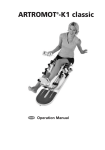

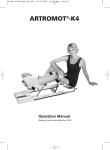
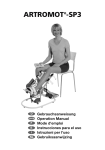
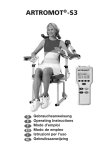
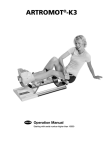
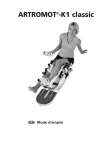
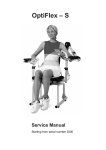
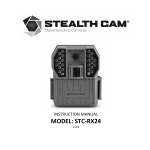
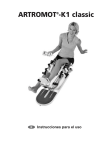
![Ball Valve [IND] Series Válvulas de bola Serie [IND] Vannes](http://vs1.manualzilla.com/store/data/006108485_1-8afd3e44d8b14a72fadc25f9e5dc4d20-150x150.png)
